Media | Articles
Your handy 1979–93 Ford Mustang (Fox-body) buyer’s guide
Like the Falcon before it, the Ford Fairmont (and the Fox chassis underneath) was the right vehicle for its time. Hailed as the “Best selling new car ever introduced”, the Fairmont didn’t just lead to the third-generation “Fox-body” Mustang; it created something magical long after its template became obsolete. The long-running Fox-body offers a fantastic combination of performance and durability, which reached mythic proportions thanks to an open-sourced, fuel-injected aftermarket. Let’s dig into why the Fox is a modern day legend that continues to suit a variety of needs.
1979
Taking advantage of the latest in computer-assisted technology, Ford designers under the leadership of Jack Telnack reimagined the original Mustang’s long-hood and short-deck proportions for a new generation. The look was revolutionary: both the two-door sedan (a.k.a. notchback or coupe) and three-door hatchback were reflections of Ford’s newfound commitment to aerodynamic efficiency (0.45 cd and 0.40 cd, respectively.) Gone was the Mustang II’s sculptural front fascia, and in its place was a wedgy, black egg crate grille and deeply recessed quad headlights. While based on the Fox Chassis, the Mustang’s cowl was taller than the Ford Fairmont, which provided an aggressive rake for the hood. The notchback sported a finned C-pillar inspired by the C107 Mercedes, while all models sported wraparound, jewel-like tail lamps and color-keyed, European-style wraparound plastic bumpers with integrated rub strips.
The Fox Mustang (and Capri sistership) sported an extensive powertrain portfolio: the Lima 2.3-liter four cylinder (88 hp), a turbocharged Lima 2.3-liter (132 hp), a 2.8-liter Cologne V-6 (109 hp), a 3.3-liter inline-six (85 hp) and the 5.0-liter Windsor V-8 (140 hp). The 5.0 and the turbocharged 2.3 were the engines of choice for performance enthusiasts, with a four-speed manual available on both. The 5.0’s manual gearbox had an overdrive, but all engine choices had an available three-speed automatic. The Fox-body’s lightweight, unitized chassis incorporated rack and pinion steering with a modern suspension (front MacPherson strut and a four-link, coil-sprung rear) in three different flavors. The first offering was intended for the baseline 13-inch tires, while the handling package was specific to the 14-inch radials, and included niceties like a rear sway bar. But the suspension uniquely engineered for Michelin’s revolutionary TRX radial tire was at the top: The TRX suspension included Michelin’s 190-65R 390 TRX tires on forged aluminum wheels, unique shocks, springs and stabilizer bars. While the automotive press praised this package, the unique tires ensured this was an evolutionary dead end a la Betamax video tapes.

Borrowing heavily from the Fairmont, the Mustang’s dashboard, steering wheel (complete with stalk mounted horn), door handles, and HVAC controls were parts bin affairs. Ford left the Fairmont’s column shifter and incomplete gauge cluster out of the equation, and a full-length console with a digital clock and LED-backed “Graphic Warning Module” was optional. Other interior options include a four-way seat adjuster, rear window defogger, an overhead map light on a positionable arm, color keyed seat belts, power locks, low back bucket seats, cruise control, air conditioning, tilt steering, interval wipers, and a rear window wipe/wash feature for three-door hatchbacks. Stereo options were shockingly numerous, there was an AM radio, an AM radio with digital clock, AM/FM radio, four-channel AM/FM stereo, an AM/FM stereo with either an 8-track or cassette player in tow, and most could be upgraded with a 48-watt Premium Sound amplifier.
There were four trim levels: Base, Sport (notchback only), Ghia, and Cobra. The sport included black body trim, color keyed window louvers, a three-spoke steering wheel and unique wheels. The luxurious Ghia included badging of the famous “Ghia” design studio, color keyed quarter window louvers, dual side view mirrors, chrome rocker moldings, door panels with map pockets, a passenger side grab handle, thicker carpeting, and Mercedes-like headrests atop the option of leather or period appropriate interior seating fabrics. While a standalone option for notchbacks, Ghia models are more likely to get the available vinyl roof compared to cheaper models. The Cobra came with the 2.3-liter turbocharged engine as standard (optional V-8), black engine turned dashboard panels, color matched window louvers, blackout exterior trim, Cobra emblems and an optional, Trans-Am like Cobra hood graphic.
Marketplace
Buy and sell classics with confidence

The most significant version might be the 1979 Indy Pace Car special edition. Sporting the TRX suspension and either the 5.0-liter or the turbocharged 2.3-liter engine, the Pace Car was differentiated by a rear spoiler, front air dam with fog lights, hood scoop (non-functional), pop-up sunroof and a unique black and pewter paint job with orange and black graphics. Recaro seats (a mid-cycle upgrade) were standard for the Pace Car, and 10,478 examples were made. Combine all versions and Ford sold 369,936 Mustangs, nearly double that of the outgoing Mustang II.
1980–81
The biggest news for 1980 was the downsized 4.2-liter Windsor V-8, likely designed in preparation for another Energy Crisis that clearly never came. The motor was created by de-boring the 5.0-liter block from 4.00″ to 3.68″ and made an uninspiring 118 horsepower. The Cobra received the front end, hood, and rear spoiler from the 1979 Pace Car, while the Cobra decal moved inside the quarter windows. Recaro sport seats were optional across all models, and available in four colors.

Lesser known changes for 1980 include a new, optional carriage roof for 2-door models that deleted the quarter window’s louvers and added a chrome A-pillar, giving a somewhat convincing impression of a convertible top. Halogen headlamps were standard, as was a maintenance free battery, and retractable cargo cover for hatchbacks. A revised center dome lamp with reading lights was standard on the Ghia, leather wrapping was now available on both the three- and four-spoke steering wheels, and non-stereo audio systems had optional dual rear speakers.
For 1981 a new removable glass T-roof option (hatchback only), and a four-speed manual, single rail overdrive (SROD) transmission was available on the turbocharged 2.3-liter. Sales figures slumped both years, with 271,322 units sold in 1980 and 182,552 in 1981.
1982
While all models received revised door panels with new armrests with integral door pulls, what everyone truly cares about is the introduction of the 5.0-liter HO (High Output) engine, optional in the new Mustang GT. All manual transmission Mustangs now used the SROD gearbox, and the naturally aspirated 2.3, 3.3, and 4.2-liter engines were retained from before. The 5.0 included a camshaft intended for marine applications, revised exhaust valves, a double-row roller timing chain, aluminum intake manifold, larger 356-cfm carburetor (vs. the outgoing 310-cfm unit), higher fuel pressure (6.5 to 8.5 psi), dual-snorkel air cleaner, and a 2 1/2-inch cat-back exhaust with a twin outlet tip. The end result was 157 horsepower and an impressive 240 lb-ft of torque, with a much fatter powerband and tricks like an A/C cutoff switch at wide open throttle.
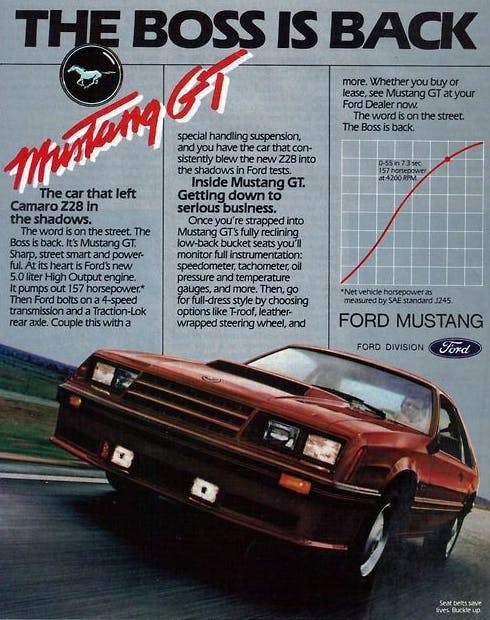
The only transmission for the new 5.0 was the SROD manual and this powertrain was most associated with the new GT trim level. The top line GT sported a body kit similar to the Cobra/Pace Car, a more performance oriented suspension, de-chromed exterior trim, and was more likely than other trim levels to possess the optional Recaro bucket seats, T-roof tops, and TRX suspension. By 1982 the lighter, more powerful Mustang GT was faster than the Camaro Z28, and Ford’s advertising wasn’t bashful about it, proclaiming “The Boss is Back” in advertising.
But the entire lineup for 1982 was shook up: L, GL, and GLX. The base model L was a two-door notchback only, with basics like manual brakes, 14-inch steel wheels and vinyl seating (cloth was optional). The mid-level GL can be ordered as a hatchback, and includes blackout trim, pin striping, full wheel covers, upgraded vinyl interior (optional cloth) and even color keyed carpeting on the door panels. The GLX replaced the Ghia, with features like dual remote sideview mirrors, nicer pin striping, rocker panel moldings, upgraded door panels with wood tone inserts, and optional leather seats.

This was the first year of the Special Service Package (SSP) Mustang, a creation owing its existence to the California Highway Patrol and their disappointment in their Camaro pursuit vehicles. Based on the Mustang L two-door Sedan, the steel wheel’d, 5.0 powered SSP Mustang were basically a production Mustang with upgrades for Police duty: 140-mph calibrated speedometer, single-key locking, relocated remote rear-decklid switch, and a radio delete. The SSP package was refined over time, but a full 406 SSP Mustangs were made in 1982, with a total of 130,418 Mustangs sold this year.
1983
The Mustang convertible made a return to the lineup after a 10-year absence, possibly thanks to the relative success of 1200 drop-tops made in 1982 by Intermeccanica Custom Coach Builders. No matter, 1983 Mustang GLX and GT convertibles left the assembly line with reinforced cowl sides, A-pillars, floors, torque boxes, quarter panels, with extra bracing in the dashboard, rear wheelhouses, and an X-brace under the floorpan for greater strength. The droptop Mustangs are shipped to Cars & Concepts in Brighton, Michigan for final assembly. The rare Mustang GT Turbo was also introduced, using a fuel injected version of the 1981 Mustang’s turbocharged 2.3-liter motor and shared with the Thunderbird Turbo Coupe: A sign of better things to come next year.

All Mustangs received a minor face-lift with a softer front end with a less aggressive egg crate grille and Ford’s corporate Blue Oval logo in the center. New taillights had standalone amber turn signals, and a smoother design that extended to the license plate. The optional sport bucket seats no longer had Recaro’s engineering prowess. The 5.0 had a Holley four-barrel carburetor with nearly double the volume (700 cfm) that netted 175 hp. Ford’s all-new, lightweight and compact “Essex” 3.8-liter V-6 (112 hp) replaced the old 3.3-liter inline six. The 5.0 had a Borg-Warner five-speed overdrive (T-5) manual transmission, but the SROD four-speed manual was available with a credit to your final bill.
Mustang Ls ditched the dog dish steel wheels for a set of sleek disc wheel covers, along with standard high back bucket seats, and the AM radio now had two speakers instead of just one. The GL received reclining low back bucket seats and two-door notchbacks even had trunk carpeting. Even with these upgrades and new offerings, only 120,873 Mustangs were sold in 1983.
1984
The Mustang celebrated its 20th birthday with the re-introduction of the turbocharged 2.3 and a special “GT-350” edition. All GT-350s were white hatchbacks or convertibles with maroon “GT-350” tape stripes, and a Mustang running pony logo on the fenders. GT-350 interiors were red with sport bucket seats and two 20th anniversary dash panel badges. The GT-350 was limited to 5260 units, but this year also marked the creation of the first Saleen Mustang (a topic too big to cover in this guide) and the SVO Mustang. A unique Quadra-Shock axle setup (a poor man’s alternative to a torque arm) for the Mustang GT, GT Turbo, and SVO. But there was plenty more to discuss about Ford’s new flagship SVO offering.
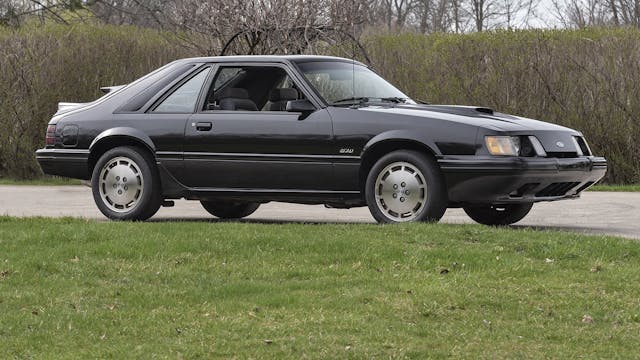
The SVO was first project of Ford “Special Vehicles Operations”, and considered the high-performance possibilities of a world where four-cylinder turbocharged engines could be our future. SVO’s received a unique front fascia with deeper air dam and wraparound turn signals, understated ground effects, a functional hood scoop for the intercooler, a bi-plane rear spoiler and pin striped taillights. Other upgrades include five-lug, 16-inch X 7-inch cast aluminum wheels, front control arms and spindles from the Fox-body Lincoln Continental, Koni shocks for each wheel and the aforementioned Quadra-shock axle, a 140-mph speedometer with no numerical markings above 85 mph, and four-wheel disc brakes from said Continental. The interior was graced with unique bucket seats, a left-foot rest, leather-wrapped steering wheel and horn pad, a toggle switch for engine timing intended for premium fuel usage, a Hurst shifter and premium sound stereo. The SVO’s engine was a step ahead of the GT Turbo thanks to an intercooler (under the off-center hood scoop) but sadly the $15,585 price tag was roughly $6000 more than a V-8 Mustang, so only 4508 were sold.

A new, corporate two-spoke steering wheel graced Mustang cabins equipped with cruise control, while all Mustangs now had the horn placed atop the steering wheel’s face. The Mustang L was available as a two-door or three-door body. Ford’s ubiquitous “LX” nameplate officially replaced both the GLX and GL models. Both the GT and GT Turbo had the once-optional sport bucket seats as standard. Central fuel injection graced the 3.8-liter V-6 (120 hp) and the 5.0 (165 hp) when equipped with Ford’s new four-speed automatic overdrive (AOD) transmission (stick shift 5.0s stuck with the Holley). These changes moved the sales needle, with 141,480 units sold for a 17 percent increase over last year.
1985
A new front end graced the 1985 Mustang, deleting the grille in favor of a slotted hole similar to that of the 1986 Ford Sierra Cosworth. The smooth bumpers mated to new body side trim, while GT models had a flat black GT hood decal and the GT logo embossed in the trim behind the doors. More importantly, the GT now had 15X7 “10-hole” wheels wearing aggressive Goodyear VR “Gatorback” tires. The same rolling stock was applied to LX models with the 5.0, while the L disappeared from the lineup entirely. The LX didn’t go downmarket to compensate, as reclining cloth seats, AM/FM stereo were standard. Even the once-decadent console was now standard on all Mustangs, except for the LX 2-door notchback.
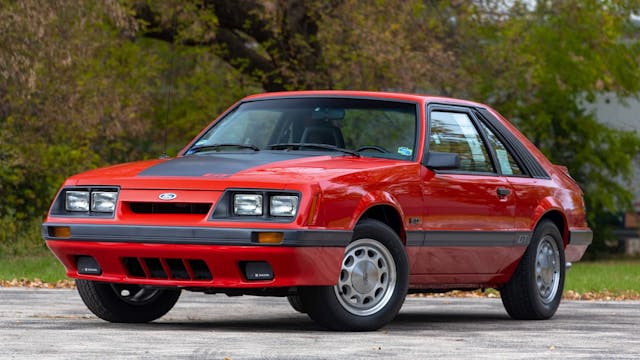
Thanks to hydraulic roller tappets and a new roller camshaft, forged aluminum pistons and stainless steel tubular headers, the 5.0 now had a robust 210 hp when equipped with the manual transmission (180 hp for automatics). While GT convertibles are 5.0 only, the roofless LX used the 3.8-liter V-6. With the GT Turbo was dropped, a mid-cycle refresh to the Mustang SVO netted flush mount headlights similar to those on the 1984 Continental Mark VII, while a power boost upped output to 205 hp, thus remaining competitive with the 5.0. A new, electronically controlled AM/FM cassette player was now optional. Wheel choices were streamlined to a set of 14-inch Polycast steel wheels, 14-inch imitation wire wheel covers, or the aforementioned 10-hole alloys for the 5.0. Thanks to all the changes, a robust 156,514 units were sold for a 10 percent increase over last year.
1986

The big news was addition of sequential port fuel injection for 5.0, for both automatic and manual transmissions. Each intake port was treated to its own fuel injector, there was a long runner aluminum intake, high swirl E6 cylinder heads, a true dual exhaust with a factory H-pipe and 2.25-inch exhaust. While this resulted in a loss of 10 hp over last year (200 total) the power peak was at a lower rpm. Sadly the losses spread to the SVO, it was downgraded to 200 hp. Sales soared in 1986, as 224,410 units moved off the lot.
1987
After the tremendous success of the Ford Taurus, a redesigned Mustang wore flush mounted lighting, and a rounder front bumper. GT models included a deep skirted, grille-less front end with integral fog lights. There were flush-mounted quarter windows and new body side moldings, while GTs had a unique body kit with side skirts, deep bumper valences, taillights without amber turn signals and with a “cheese grater” texture, and (optional) two-tone paint. The LX model received updated taillights, and 10-hole wheels were now unique to the LX 5.0, as the GT sported lighter turbine wheels in the same size. The older T-roof configuration was still available, and all three Mustang body styles received a red (or blue) stripe integrated into the moldings.

Powertrain options were simplified, as both the turbocharged 2.3-liter four and the 3.8-liter V-6 were deleted. The 5.0 received E7 cylinder heads from the F-series, which bumped compression to 9:1 and raised output to 225 hp with an impressive 300 lb-ft of torque.The lighter and cheaper Mustang LX 5.0 sedan could run the quarter-mile in the mid-14s right from the factory, leaving similarly optioned Camaros far behind. The 5.0’s forged pistons now sported valve reliefs, which made way for hotter camshafts from Ford Motorsport (and aftermarket vendors) without fear of ruining the short block. The GT’s sported a subtle exhaust system that let the deep skirted rear bumper run wild, while the 5.0 LX had the 1986 Mustang’s double barrel shotgun system. Suspension improvements came via revised MacPherson struts, front spindles and larger (11-inch) front brake rotors.
The 1987 interior featured a bespoke steering wheel, flat black gauge pod with full instrumentation and auxiliary switches for headlights, fog lights, hazard flashers and power top (convertible only) facing the driver. If you’ve ever spent time in an Audi 4000, this arrangement will feel familiar. The HVAC controls were above the radio in the center of the dash, and were of the rotary variety. Options included a tilt steering wheel, 6-speaker premium sound, and a 7-band graphic equalizer. GT models included standard lumbar support seats with oversized headrests and adjustable thigh supports. Even with all the changes and performance improvements, the 1987 Mustang only sold 169,772 units, down about 24 percent from 1986.
1988

While California models received a Mass Air Flow (MAF) sensor which restricted engine output by 2 to 3 horsepower, this was both a minor concern and a springboard for the Fox Mustang’s higher performance future. No other significant changes occurred, and sales increased 24 percent to 211,225.
1989

All 5.0s received the MAF sensor (albeit a different design than last year) and the once optional, uprated suspension from the Mustang GT was now standard on the LX 5.0. Though the MAF has very little benefit to a stock 5.0 outside of emissions controls, 1989 Mustangs have better drivability when modified with aggressive modifications like camshaft swaps. 5.0s switched to a 140-mph speedometer while the hatchback’s T-roof option was deleted. Less impressive was the Mustang’s mid-cycle, silver anniversary celebration: from April 17, 1989, Ford added a commemorative running pony emblem on the passenger side of the dashboard. While rumors of a high-performance model abound (including a 5.8-liter powered prototype) none came to fruition. A slight dip in sales occurred this year, with 209,769 units sold.
1990
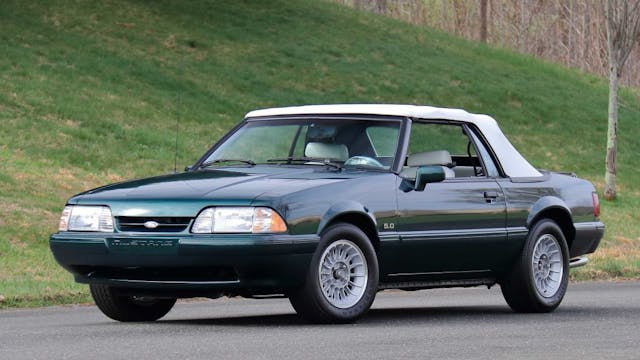
A driver’s side air bag was standard, which sadly deleted the tilt steering column. Even worse, the deletion of the center console’s armrest was a rare lapse in judgement, but the addition of map pockets in each door added more storage options. The sport bucket seats in the GT now used the smaller headrests of cheaper Mustangs.
For the Mustang’s formalized 25th anniversary, a run of 4103 LX 5.0 convertibles came finished in emerald green with a white top and a white leather interior. These were also noteworthy for having the GT’s turbine wheels, and for being part of a promotional giveaway for employees of the 7 up beverage company (with “7 up” hood badging). All 1990 models retained the aforementioned dashboard emblem to continue the anniversary celebrations. Only 128,189 Mustangs were sold this year, down 39 percent.
1991
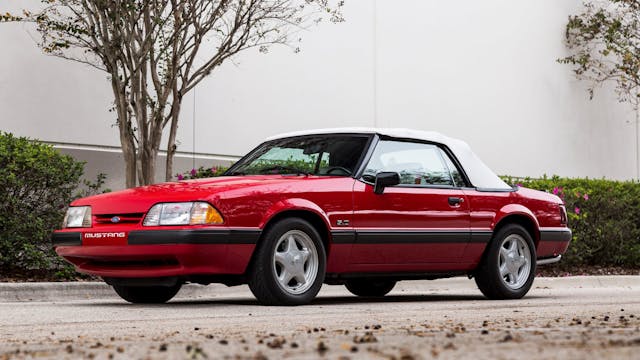
This year marks the introduction of the 16-inch, five-spoke, “Pony” rims with the Mustang running pony displayed prominently on the center cap. These were standard on both the 5.0 LX and GT models, and necessitated a revised fender and steering rack limiters to accommodate the new rolling stock. The dashboard’s running pony logo from 1989–90 remained, but without “25th Anniversary” lettering. The HVAC controls received smaller knobs and more straightforward lettering, and the center armrest came back to the roster. Convertible Mustangs benefitted from a sleeker profile when the re-engineered top was retracted.
While the 5.0 badge became synonymous with performance, and while aftermarket parts suppliers were selling 5.0 parts in staggering numbers, a new cylinder head with two spark plugs per cylinder also graced the 2.3-liter engine. Horsepower was up to 105 (+15 hp) for the base Mustang, but all these minor changes resulted in an overall sales decline: only 98,737 Mustangs were sold.
1992

Changes were modest, as color-keyed bodyside moldings (LX) replaced the black belt from older versions. A new interior dome light, cheaper seat cushions without adjustable thigh supports, and a four-way power adjustable seat were optional. A limited run of 2019 5.0 LX convertibles were made with bright orange paint, white leather interiors with red piping, and a rear spoiler in place of the luggage rack. White painted 16-inch pony wheels were also part of this package. The Fox was starting to feel its age, as only 79,280 were sold this year.
1993
In its final year of production, the Fox-body Mustang included a new Cobra model with significant improvements. Created by Ford’s new Special Vehicle Team (SVT) the Cobra engine upgrades included the GT-40 heads and a cast-aluminum version of the GT-40 intake available from Ford Motorsport, roller rockers, and 14 percent underdrive pulleys. The end result wasn’t impressive on paper: 235 horsepower and a disappointing 280 lb-ft of torque. The cheaper 5.0 Mustangs were now rated at 205 horsepower (-20hp) even though there were no significant changes, aside from a switch from forged to hypereutectic pistons.

The Cobra’s other modifications were more impressive: rear disc brakes (from the 1987 Thunderbird Turbo), revised T-5 transmission, 17 x 7.5-inch wheels, and a toned-down pairing of springs, shocks, and swaybars made the Cobra a finesse player in the corners. Styling features included Mustang SVO taillights (with charcoal pinstriping), a retro grille with the running pony logo, Cobra fender emblems, a unique rear spoiler and a cleaner version of the body kit seen on Mustang GTs. Cobra color choices were limited to teal metallic, red, and black, but cruise control was surprisingly absent in the top-tier Mustang’s black or gray interior.

While 4993 Cobras made production, an additional 107 Cobra R models were built to compete in SCCA showroom-stock racing. The Cobra Rs had a featureless interior worthy of the 1979 Mustang, complete with four-cylinder Mustang bucket seats, but also lacks the back seat. The big draw was the 5-lug “tri-bar” 17-inch wheels and 13-inch front rotors, eventually becoming hallmarks of the SN-95 Mustang. Cobra R’s also sported engine and power steering oil coolers, and a radiator from the 2.4-liter diesel Fox Body Lincolns.
All 1993 Mustangs benefited from an optional in-dash CD player, and two limited edition LX convertibles came mid year. One was triple white (white paint/top/interior) with a rear spoiler and white Pony wheels. The second was yellow with either a black top and black leather interior or a white top and white leather interior. The yellow convertible also had a decklid spoiler, but stood out thanks to chrome-plated Pony rims. Ford built 1500 white and 1503 yellow LX convertibles. Perhaps not surprisingly, the new models boosted sales to 114,228, roughly 44 percent higher than last year.
Before you buy
Thanks to a healthy aftermarket presence and the Fox Mustang’s general durability, the risks associated with buying one in nearly any condition is low. Checking for rust in the unibody is important, but aftermarket patch panels are plentiful and affordable. The bigger concern is structural integrity as the rear lower control arms’ torque boxes are a weak point: any 5.0 Mustang with even a remote chance of having drag radials or racing slicks in its past is likely to need reinforcement. Look for signs of flex or a poor repair here, but keep in mind the aftermarket also has this issue covered too.

Collision repair is also a concern because of the 5.0 Mustang’s propensity for street racing history. While repair panels are plentiful and unibody straightening is commonplace, the price must accurately reflect the true condition. Interiors are generally hard-wearing and easy to restore, but make a note of the cost of replacement parts for common things like vandalized HVAC registers, cracked dash tops (1979–86), cracked instrument bezels, degraded AOD throttle cable bushings, and broken ashtray doors. Test drives are crucial to find evidence of abuse, especially for models with the T-5 manual transmission. Feel for bad synchros in the gearbox, as that’s one of the few weak links in a Fox Mustang’s powertrain. If you’re looking at an example with an aftermarket shifter, rest assured it has been driven hard at least once in its past. Not a big deal, as almost everything needed to repair these vehicles is available, but the asking price must reflect the restoration costs involved.
A large subset of Fox Mustangs were modified in the 1990s and 2000s. In terms of performance upgrades, they can be classified as invisible (11-inch front brakes on a 1979–86) or highly visible (five-lug brake conversions). Some are valuable (brand name parts from Ford Motorsport, Saleen, Griggs, etc.) while others hurt performance (70-mm throttle body on a stock 5.0) or narrow their appeal (temperamental race camshafts). And just because you’re looking at a 5.0 doesn’t mean it wasn’t a 2.3-liter in a previous life: Tell tale signs include a non-functional gauge cluster or body buck tag denoting a different engine. It’s crucial to know what you want, then seek out examples that come closest to meeting expectations.
Lastly, a note about originality: while low mileage originals abound, those with multiple owners were likely modified before the current seller took possession. If a seemingly original 1986–93 Mustang is missing the air box’s silencer (inside the fender), or if the mufflers do not have Ford part numbers stamped on them, odds are it had deeper modifications in its lifetime. Take your time and look closely to ensure you are getting what you pay for.
Valuation
The Hagerty Valuation Team has significant insight into Fox-body Mustang prices, but please check here for the latest values. It’s difficult to speak in generalities, as Fox Mustangs include over 100 vehicles with #2-condition (Excellent) values ranging from $7100 to $90,300. That said, these have appreciated since the mid-2010s after dipping significantly during the Recession: They jumped past their pre-2008 values in 2016. Since 2013, the median #2 value for 1979–93 Mustangs is up 132 percent. Some earlier cars are only up in the 40 percent range, but later 5.0 Mustangs (LX notchback models in particular) have a larger following. The 1993 SVT models appreciated the most, with the Cobra up 190 percent and the Cobra R up 140 percent.
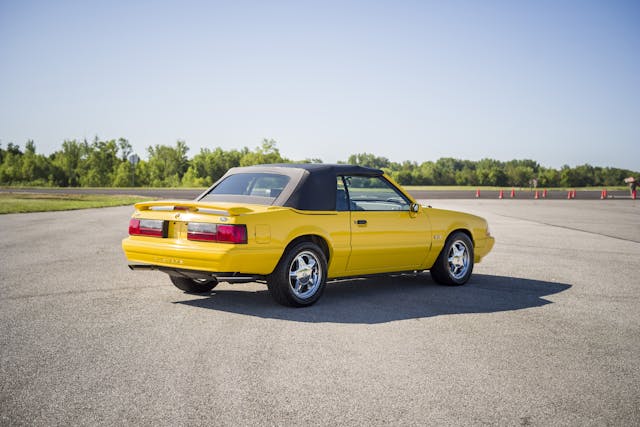
Hagerty’s median quoted value is $9400, with quoted value rising 21 percent over the past 5 years and the number of quotes is up 24 percent. Pre-boomers quote 4 percent of Mustangs while making up 7 percent of the market. Boomers quote 23 percent of Mustangs with 38 percent of the market and Gen-Xers quote 44 percent of Mustangs with 31 percent of the market. While it’s logical that Gen-Xers are going after the cars of their youth, it’s surprising to see millennials and Gen-Z quoting 23 percent/6 percent with 19 percent/6 percent of the market, respectively.
This generation of Mustang is a transitional vehicle that caters to multiple generations, and made a contribution to the advent of modern, fuel injected hot rodding. Never before was there such a demand for open sourced performance parts, and no longer was the Chevy 350 synonymous with performance. And now the Fox-body is a modern classic that’s only getting more popular and valuable as time goes by.









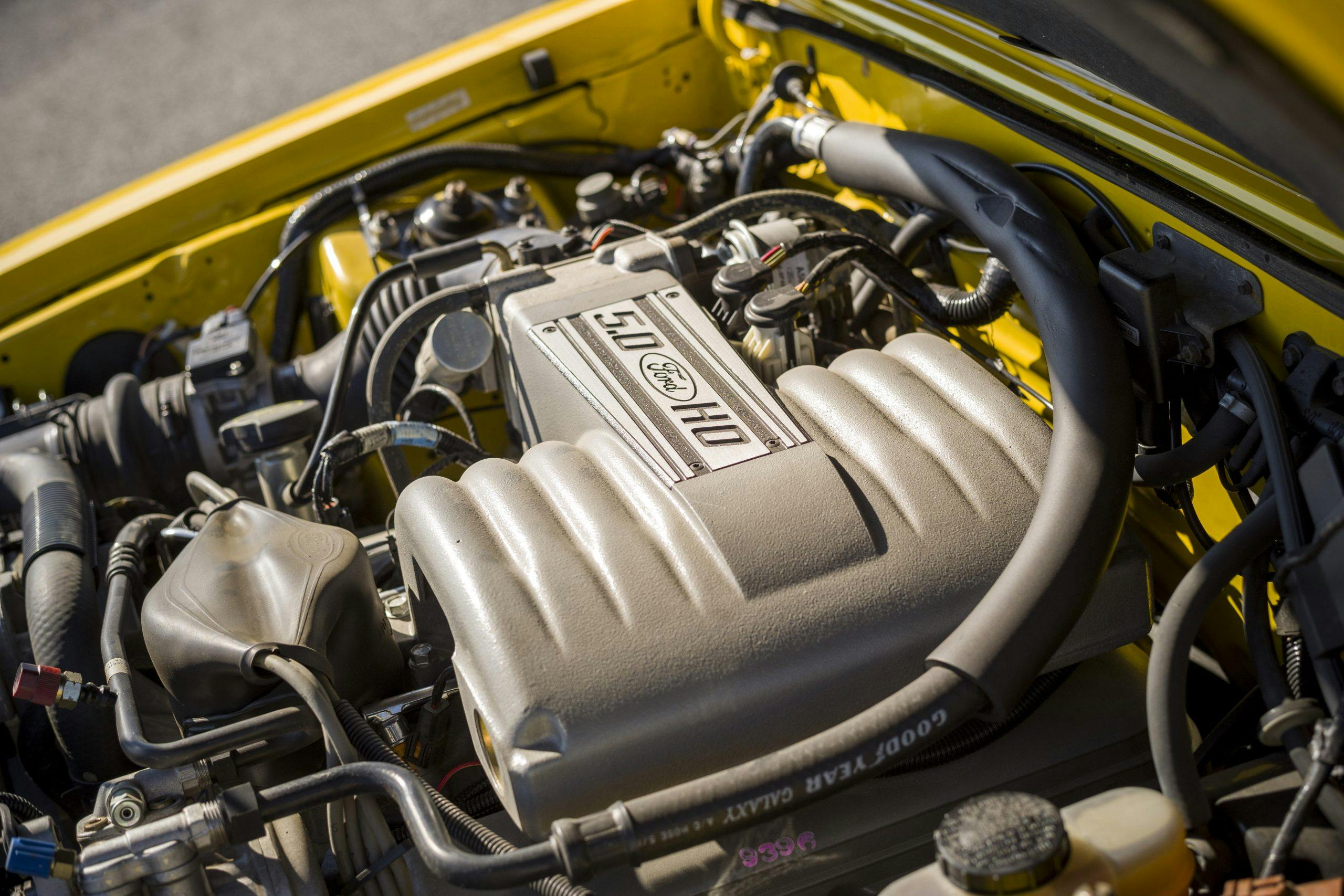
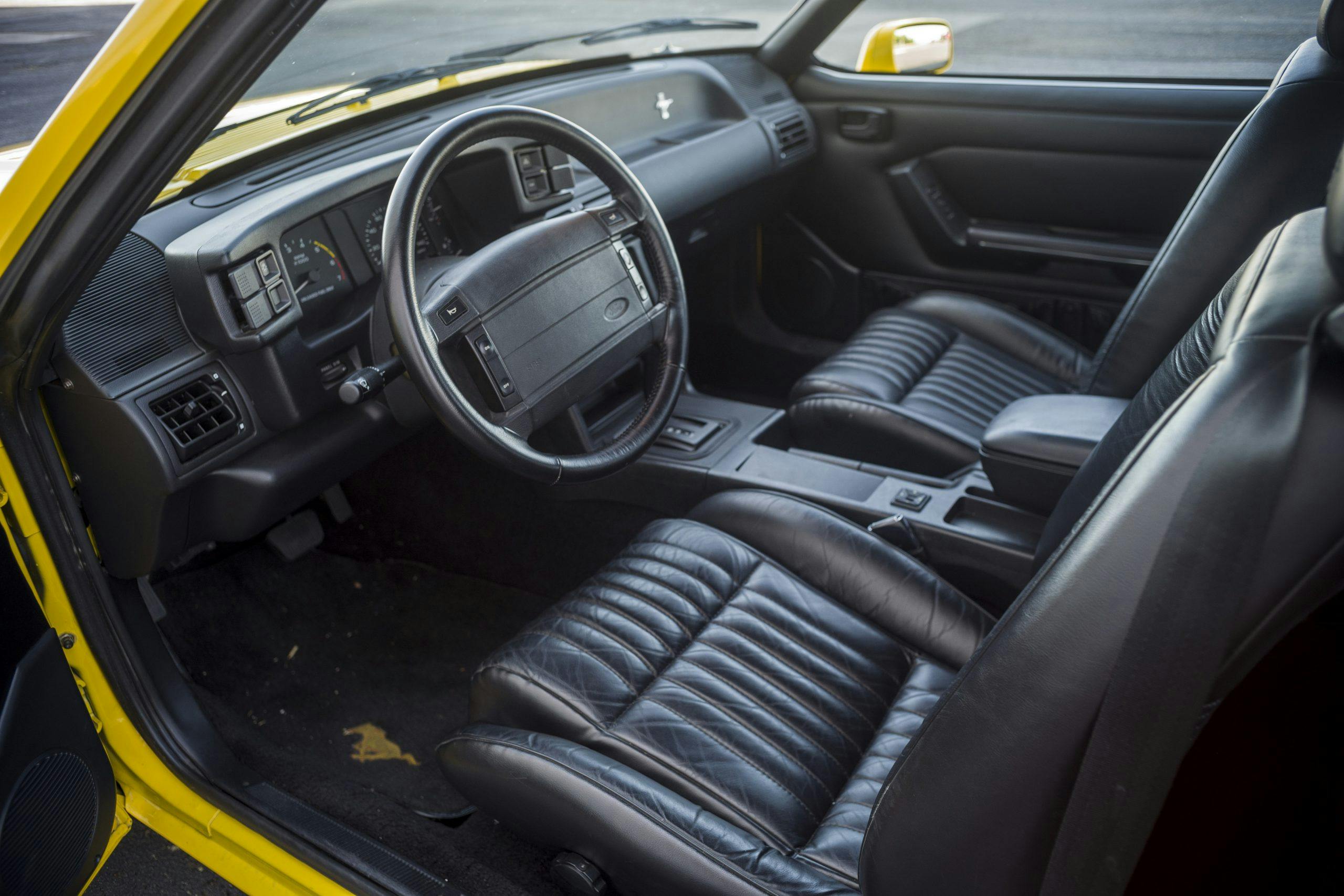
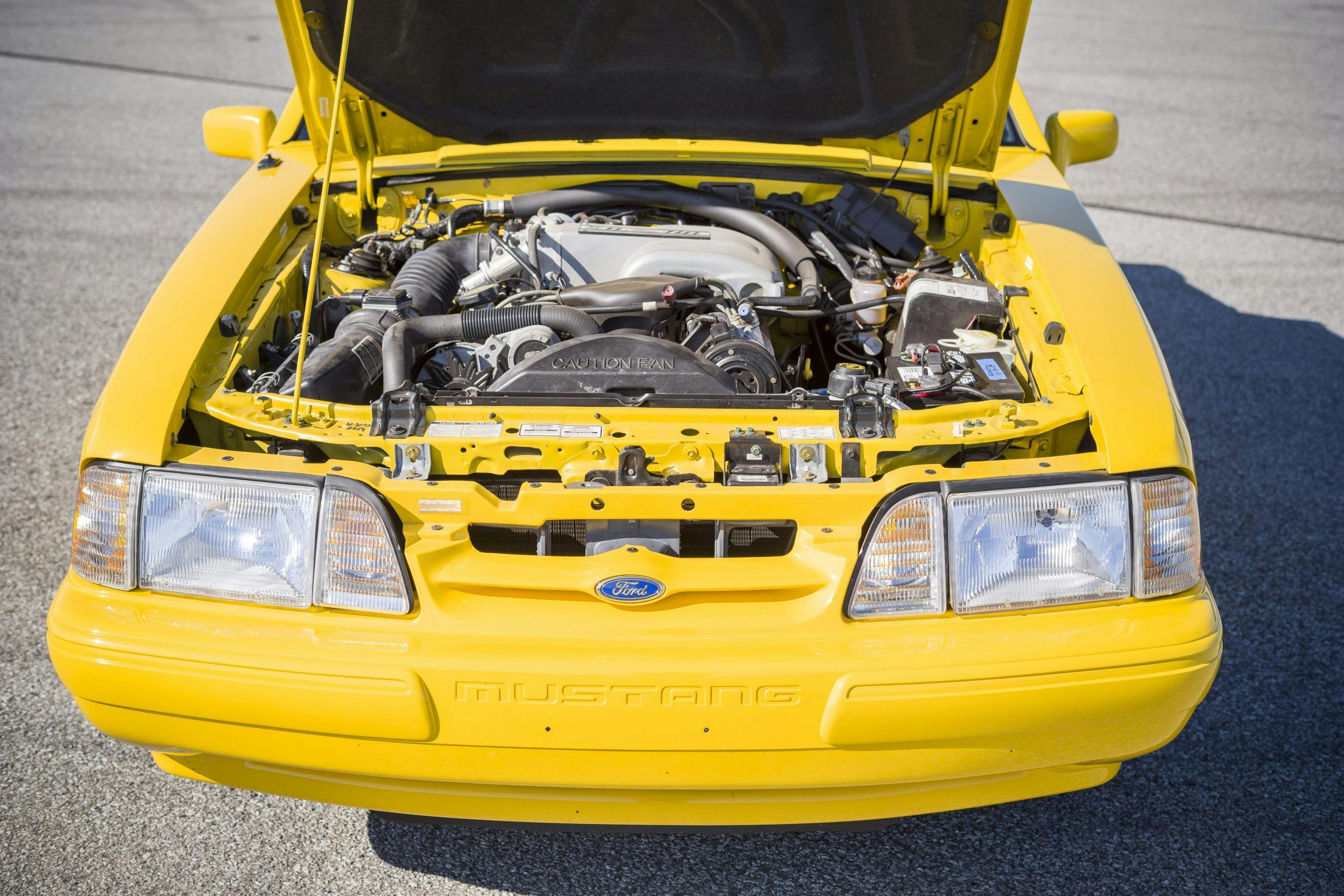

















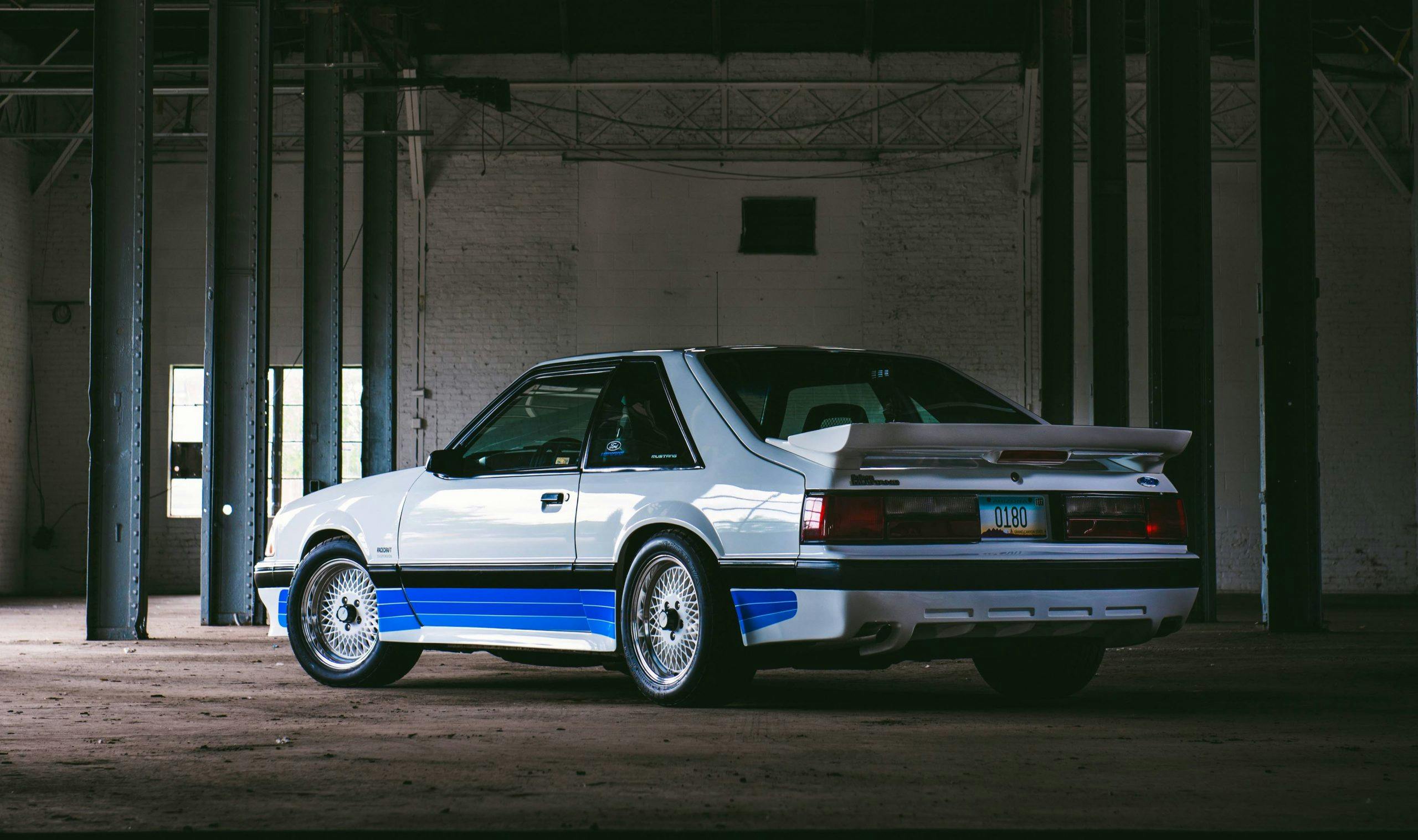
i am a real good driver
Arent preboomers someone that was born around WW2? i have always heard baby boomers were born after the war so pre boomers must have been born before, ha ha ha ha, i have never seen anyone like that driving one of these cars thats why i asked, i have 2 of these cars and have had them since the early 90s and i was born in the early 70s , also these are cars to have fun with and enjoy,they are not retirement plans,if things continue they way they are going with these electric cars anything with a gasoline engine (even a Aztec) is going to be extremely valuable or a pile of junk in a couple of decades,lol